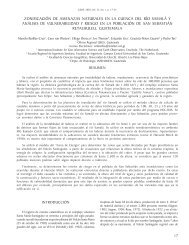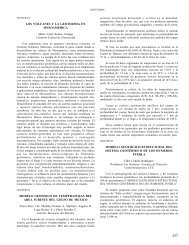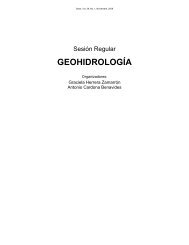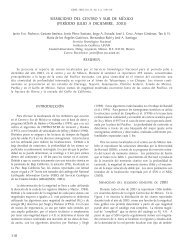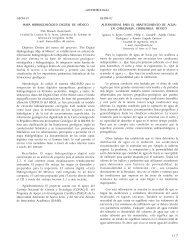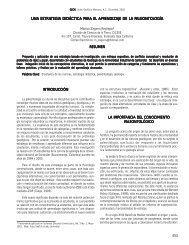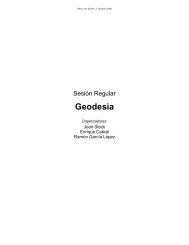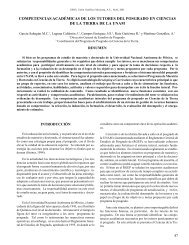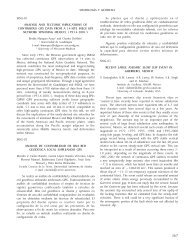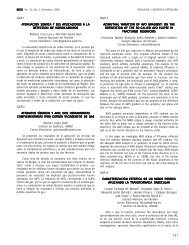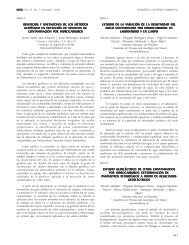SISMOLOGÍA Geos, Vol. 27, No. 1, Octubre, 2007there occurred the October 17-18, 1992, seismic sequence withmagnitu<strong>de</strong>s Mw 6.6 and 7.1 respectively.This zone, located in northwestern Colombia has beenseismically monitored by INGEOMINAS (the ColombianGeological Survey) since the early 90´s, and the seismicsequence of 1992 has been studied by several authors who haveanalyzed the damages caused and some possible mo<strong>de</strong>ls for theseismic source.In this paper we present a mo<strong>de</strong>l for sources of changesin stress and seismicity with complex elements for geologicalfaults -theoretical or observed in the field- in or<strong>de</strong>r to test thehypothesis that the 1992 Murindó seismic sequence changed thestatic stresses in nearby faults such as Murindó, MurrÃ-, andothers, as well as in other seismically active areas, influencing thelocal seismicity. For the first time we test the hypothesis of staticstresses changes and their possible implications for the seismichazard in Colombia. We do this using Coulomb 3.0 software.Aditionally we also report on the increase in the microseismicityof the region <strong>de</strong>tected in 2004.SIS-12ANÁLISIS DE LA RUPTURA EN ALTAI, ASIA CENTRAL,MODELADO DEL SISMO PRINCIPAL Y RÉPLICASMAYORES DEL 27 SEPTIEMBRE DE 2003 (MW7.4)Gómez González Juan Martín 1 , Mellors Robert 2 y Mendoza Carlos 11 Centro <strong>de</strong> Geociencias, UNAM2 Department of Geological Sciences, San Diego State University, USAgomez@geociencias.unam.mxEl análisis cinemático <strong>de</strong>l proceso <strong>de</strong> ruptura <strong>de</strong>l sismo <strong>de</strong>Altai, <strong>de</strong>l 27 <strong>de</strong> septiembre <strong>de</strong> 2003, muestra un mecanismo focalprioritariamente transcurrente. Se trata <strong>de</strong> uno <strong>de</strong> los mayoresterremotos (Mw7.3) que han ocurrido en las cordilleras <strong>de</strong>l Asiacentral, en los últimos 50 años. La inversión <strong>de</strong> la forma <strong>de</strong>onda, con ondas <strong>de</strong> volumen, muestra una geometría <strong>de</strong> fallacon un azimut <strong>de</strong> 130° y un ángulo <strong>de</strong> <strong>de</strong>slizamiento <strong>de</strong> 170°,sobre un plano subvertical (echado=75°). Dichas característicascoinci<strong>de</strong>n con una <strong>de</strong> las estructuras mayores que componen lacordillera <strong>de</strong> Altai, así como con la orientación <strong>de</strong> la distribución<strong>de</strong> réplicas. El mo<strong>de</strong>lado <strong>de</strong> los datos telesísmicos tambiénproporciona una profundidad <strong>de</strong>l centroi<strong>de</strong> <strong>de</strong> 10 km y unmomento escalar aproximado <strong>de</strong> 0.688·1020 N m, asociado a unaduración <strong>de</strong> la fuente <strong>de</strong> 25 s. Dicha duración permite estimaruna longitud máxima <strong>de</strong> ruptura aproximada <strong>de</strong> 60 – 90 km. Elsismo principal tuvo varias réplicas muy cercanas tanto en eltiempo como en el espacio. Dos réplicas ocurrieron el mismodía (Mw5.7, Mw6.4) y otra ocurrió el 1 <strong>de</strong> octubre <strong>de</strong> 2003.La mejor relación señal ruido <strong>de</strong> la segunda réplica (Mw6.4)permite mo<strong>de</strong>lar su forma. Esta réplica tiene varias similitu<strong>de</strong>sgeométricas con respecto al evento principal, el mecanismo focaltiene un azimut <strong>de</strong> 128°, un echado <strong>de</strong> 71° y un ángulo <strong>de</strong><strong>de</strong>slizamiento <strong>de</strong>154°, con una profundidad <strong>de</strong>l centroi<strong>de</strong> <strong>de</strong> 13km. Las diferentes soluciones reportadas sobre el sismo principaldifieren ligeramente entre sí, sin embargo, estas diferencias seincrementan cuando se comparan éstos mo<strong>de</strong>los con los mo<strong>de</strong>los<strong>de</strong> <strong>de</strong>formación InSAR. Entre las principales discrepancias estánla dirección <strong>de</strong> los <strong>de</strong>splazamientos, la posición <strong>de</strong> hipocentro y laestimación <strong>de</strong>l momento escalar. Mediante el mo<strong>de</strong>lado <strong>de</strong> fuentepuntual y <strong>de</strong> falla finita realizamos un análisis <strong>de</strong> sensibilidad <strong>de</strong>algunos parámetros (hipocentro, momento escalar y la duración<strong>de</strong> la función fuente). Los mo<strong>de</strong>los InSAR no sólo incluyen elmovimiento cosísmicos sino las contribuciones <strong>de</strong> otros eventos,a<strong>de</strong>más, <strong>de</strong> correspon<strong>de</strong>r a periodos <strong>de</strong> registro más largos.Diferentes mo<strong>de</strong>los indican que la estimación <strong>de</strong> los parámetros<strong>de</strong> la fuente se ve afectada por el mo<strong>de</strong>lo <strong>de</strong> corteza y lageometría <strong>de</strong> la fuente sismogénica usados. La comparación <strong>de</strong>parámetros reportados por diferentes datos permite <strong>de</strong>scartarlos mo<strong>de</strong>los pobremente restringidos y conservar aquello másapegados a las características tectónicas actuales <strong>de</strong> la región.SIS-13DETECTION OF AN ASEISMIC SLIP TRANSIENT IN EARLY2007 FROM THE OAXACA GPS AND SEISMIC ARRAYCabral Cano Enrique 1 , DeMets Charles 2 , Brudzinski Michael R. 3 , DíazMolina Oscar 1 , Arciniega Ceballos Alejandra 1 y Correa Mora Francisco 21 Instituto <strong>de</strong> Geofísica, UNAM2 Department of Geology and Geophysics, University of Wisconsin, USA3 Department of Geology, Miami University of Ohio, USAecabral@geofisica.unam.mxGPS measurements along the Oaxaca segment of the MiddleAmerica Trench since 1995 show a remarkable history of episodicslow slip transients that affect wi<strong>de</strong> areas of Southern Mexico. Todate, the existence or lack thereof of tremor-like seismic activitythat may be associated with the geo<strong>de</strong>tically recor<strong>de</strong>d transientslip is unknown, primarily due to the lack of regional-scalecontinuous seismic measurements. To overcome this and betterun<strong>de</strong>rstand how these transients factor into the earthquake cycleof southernMexico, we have installed a continuous, largely co-locatedseismic and GPS array extending from the Mexico volcanicbelt to the Pacific coast of Oaxaca. Consisting of 11 GPSand 9 seismic stations, the array can accurately resolve theexistence and location of episodic strain and any associatedseismic tremor and provi<strong>de</strong>s the observational capabilities forstudying the relationship between the surface <strong>de</strong>formation andseismic energy release during both earthquakes and episodic,transient slip. The first event that has been <strong>de</strong>tected by thisexpan<strong>de</strong>d network occurred in between March 25 and May 15,2007. Some of this transient slow-slip event data is still returningfrom the field, but our initial analysis based on currently availabledata from Internet networked sites reveals a larger amplitu<strong>de</strong>southwestward motion for stations located further inland, and asmaller-amplitu<strong>de</strong>, westward motion at coastal sites and possiblyat other sites located further north on the Mexican VolcanicBelt. Results from the extent of correlation between the seismicand geo<strong>de</strong>tic data will also be presented. The 2007 transientevent reinforces the previous observation that periodic slowslip events are a key characteristic of the earthquake cycle insouthern Mexico, presumably due to the shallow subduction thatplaces large areas of the subducting Cocos plate in a frictionallytransitional zone that is capable of generating these transients.118
Geos, Vol. 27, No. 1, Octubre, 2007SISMOLOGÍASIS-14ASEISMIC SLOW SLIP EVENTS INMÉXICO FROM TIDE GAUGE RECORDSAlva Vázquez Abraham 1 y Kostoglodov Vladimir 21 Facultad <strong>de</strong> Ciencias, UNAM2 Instituto <strong>de</strong> Geofísica, UNAMabrahamavaz@yahoo.com.mxTi<strong>de</strong> gauge records from the Pacific coast of Mexico provi<strong>de</strong>very important information on the occurrence of earthquakes andaseismic slow slip events (SSE) in the pre-GPS epoch. The goalof this study is to extract a tectonic signal from the ti<strong>de</strong> gauge databy applying different filtering technique. Anomalous changes ofthe residual sequence represent possible coastal uplift producedby seismic and aseismic events and should find an a<strong>de</strong>quateinterpretation. A simple difference between the Manzanillo (MNZ)and Acapulco (ACA) monthly averaged ti<strong>de</strong> records reveals ~20cm uplift in Acapulco produced by 1962 Mw7 earthquake doublet,and a few inconsistent slow sea level changes of 5-15 cm whichcan not be attributed directly to any of known large seismic events.Ti<strong>de</strong> and el Niño (ENSO) effects overshadow slow tectonic signalin the sea level records. We removed a seasonal and a fewsignificant ti<strong>de</strong> components using the results of harmonic analysisof ti<strong>de</strong> gauge data and then applied a linear regression betweenthe residual ti<strong>de</strong> gauge signal and ENSO data to partially filter sealevel changes caused by el Niño. Finally the filtered difference ofMNZ-ACA ti<strong>de</strong> gauges records yields more reliable estimates ofslow coastal uplifts in Acapulco of 5.4±5.3cm in 1957, 14±3cmin 1972 and a subsi<strong>de</strong>nce of 5±3cm in 1979 in Mansanillo. Weinterpret 1957 anomaly as uplift from SSE triggered by Mw7.8Jul.28, 1957 San Marcos earthquake. Slow (~6 months) uplift in1972 is not related to any known large earthquake in Mexico andmay be the largest ever recor<strong>de</strong>d SSE. It is of note that this SSEhas occurred only 10 years after the 1962 Acapulco earthquakedoublet. It is difficult to explain the 1979 slow subsi<strong>de</strong>nce inManzanillo if not to suppose that a SSE has <strong>de</strong>veloped here onthe seismogenic part of the plate interface in front of the coast.SIS-15RUIDO, ¿HASTA DÓNDE LLEGA SU EFECTO?Real Pérez Jorge Arturo 1 y Pérez Campos Xyoli 21 Facultad <strong>de</strong> Ingeniería, UNAM2 Instituto <strong>de</strong> Geofísica, UNAMjorge8428@yahoo.com.mxMASE (Meso-American Subduction Experiment) es unproyecto que tiene como objetivo principal crear un mo<strong>de</strong>lo <strong>de</strong>la subducción <strong>de</strong> la placa <strong>de</strong> Cocos por <strong>de</strong>bajo <strong>de</strong> la placaNorteamericana. Para este fin se instalaron 100 estaciones <strong>de</strong>banda ancha, registrando a 100 muestras por segundo (~3#1011por año), a lo largo <strong>de</strong> una línea que va <strong>de</strong>s<strong>de</strong> Acapulco, Gro.,hasta Tempoal, Ver., siendo el D. F. el punto medio <strong>de</strong> estalínea. Los criterios usados en la selección <strong>de</strong> sitio incluyeron lacalidad <strong>de</strong>l sitio (niveles <strong>de</strong> ruido y efecto <strong>de</strong> sitio esperados),su localización con respecto a la línea MASE, la seguridad <strong>de</strong>lequipo, el acceso a la estación y la línea <strong>de</strong> la vista para el50% <strong>de</strong> ellas, ya que transmitieron en tiempo real; sin embargo,se dio una prioridad más alta a su ubicación con respecto ala línea y la seguridad <strong>de</strong>l equipo. El objetivo <strong>de</strong> este trabajoes caracterizar el nivel <strong>de</strong> ruido a diferentes frecuencias <strong>de</strong> lasestaciones <strong>de</strong>l proyecto MASE, para por un lado, po<strong>de</strong>r evaluarla calidad <strong>de</strong> la señal, y por el otro, evaluar los efectos en fuentes<strong>de</strong> ruido particulares a lo largo <strong>de</strong>l arreglo y durante el tiempo.Para lograrlo, analizamos para cada una <strong>de</strong> las estaciones undía <strong>de</strong> datos por mes, <strong>de</strong> los 2.5 años que duró el experimento.Observamos que la mayoría <strong>de</strong> las estaciones tienen niveles<strong>de</strong> ruidos <strong>de</strong>ntro <strong>de</strong> los parámetros propuestos por Peteterson(1993), con picos en las curvas <strong>de</strong> ruido entre 6 y 7 s <strong>de</strong> periodo,atribuibles al golpe <strong>de</strong> las olas sobre la costa, los cuales sonmás evi<strong>de</strong>ntes en las estaciones que están cercanas a éstas,atenuándose conforme se a<strong>de</strong>ntra al continente. También seanalizó el incremento <strong>de</strong>l ruido <strong>de</strong> alta frecuencia, así como ladiferencia <strong>de</strong> este ruido entre el día y la noche en las estacionesque se encuentran <strong>de</strong>ntro <strong>de</strong> las ciuda<strong>de</strong>s, cercanas a víastransitadas por vehículos o <strong>de</strong>ntro <strong>de</strong> edificios públicos (escuelas,instituciones, etc.). A<strong>de</strong>más, se encontraron algunas diferenciasen las amplitu<strong>de</strong>s y las frecuencias <strong>de</strong> las señales en diferentesépocas <strong>de</strong>l año, como los son la temporada <strong>de</strong> huracanes, elinvierno, el verano, etc. Lo que se preten<strong>de</strong> con estos resultadoses que otros estudios puedan consi<strong>de</strong>rar estos efectos parasus objetivos particulares, pudiendo seleccionar estaciones y/oseñales óptimas.SIS-16EL PRINCIPIO DE HUYGENS Y LA DETERMINACIÓNDEL TIEMPO DE RECORRIDO Y LA AMPLITUDDE FRENTES DE ONDA EN EXPANSIÓNMadrid González Juan y Frez Cár<strong>de</strong>nas JoséDivisión <strong>de</strong> Ciencias <strong>de</strong> la Tierra, CICESEjuaneu@cicese.mxEl frente <strong>de</strong> onda <strong>de</strong> una onda en propagación es unasuperficie en tres dimensiones o una curva en dos dimensiones.En cualquier caso, en cada punto posee un radio <strong>de</strong> curvaturay un centro <strong>de</strong> curvatura. En este trabajo se <strong>de</strong>muestra,combinando las ecuaciones <strong>de</strong> Euler-Lagrange para el problema<strong>de</strong> tiempo mínimo con i<strong>de</strong>as <strong>de</strong> la geometría diferencial, queen un medio con una velocidad que es una funcion arbitraria<strong>de</strong> las coor<strong>de</strong>nadas el parámetro que <strong>de</strong>fine las lentitu<strong>de</strong>s en laaproximación geométrica es igual al radio <strong>de</strong> curvatura <strong>de</strong>l frente<strong>de</strong> onda multiplicado por la velocidad sobre el frente <strong>de</strong> onda. Paraeso encontramos primero las ecuaciones <strong>de</strong> movimiento para elcentro <strong>de</strong> curvatura y para el radio <strong>de</strong> curvatura. La continuidad<strong>de</strong>l parámetro RV en una frontera entre medios implica la ley <strong>de</strong>Snell.Para velocida<strong>de</strong>s constantes, la ecuación <strong>de</strong>l radio <strong>de</strong>curvatura se reduce al principio original <strong>de</strong> Huygens, sin elproblema <strong>de</strong> la envolvente rece<strong>de</strong>nte. Para velocida<strong>de</strong>s que noson constantes la teoría aña<strong>de</strong> una corrección al principio <strong>de</strong>Huygens en términos <strong>de</strong>l gradiente <strong>de</strong> velocidad. La variableRV controla la amplitud <strong>de</strong> la onda, tanto en medios continuoscomo en discontinuida<strong>de</strong>s, don<strong>de</strong> la condición <strong>de</strong> frontera esprecisamente la ley <strong>de</strong> Snell, haciendo posible y facilitando eltrazado <strong>de</strong> rayos dinámico. Se dan algunos ejemplos simples <strong>de</strong>la solución <strong>de</strong> las ecuaciones diferenciales obtenidas.119
- Page 1 and 2:
Geos, Vol. 27, No. 1, Octubre, 2007
- Page 3 and 4:
Geos, Vol. 27, No. 1, Octubre, 2007
- Page 5 and 6:
Geos, Vol. 27, No. 1, Octubre, 2007
- Page 7 and 8:
Geos, Vol. 27, No. 1, Octubre, 2007
- Page 9 and 10:
Geos, Vol. 27, No. 1, Octubre, 2007
- Page 11 and 12:
Geos, Vol. 27, No. 1, Octubre, 2007
- Page 13 and 14:
Geos, Vol. 27, No. 1, Octubre, 2007
- Page 15 and 16:
Geos, Vol. 27, No. 1, Octubre, 2007
- Page 17 and 18:
Geos, Vol. 27, No. 1, Octubre, 2007
- Page 19 and 20:
Geos, Vol. 27, No. 1, Octubre, 2007
- Page 21 and 22:
Geos, Vol. 27, No. 1, Octubre, 2007
- Page 23 and 24:
Geos, Vol. 27, No. 1, Octubre, 2007
- Page 25 and 26:
Geos, Vol. 27, No. 1, Octubre, 2007
- Page 27 and 28:
Geos, Vol. 27, No. 1, Octubre, 2007
- Page 29 and 30:
Geos, Vol. 27, No. 1, Octubre, 2007
- Page 31 and 32:
Geos, Vol. 27, No. 1, Octubre, 2007
- Page 33 and 34:
Geos, Vol. 27, No. 1, Octubre, 2007
- Page 35 and 36:
Geos, Vol. 27, No. 1, Octubre, 2007
- Page 37 and 38:
Geos, Vol. 27, No. 1, Octubre, 2007
- Page 39 and 40:
Geos, Vol. 27, No. 1, Octubre, 2007
- Page 41 and 42:
Geos, Vol. 27, No. 1, Octubre, 2007
- Page 43 and 44:
Geos, Vol. 27, No. 1, Octubre, 2007
- Page 45 and 46:
Geos, Vol. 27, No. 1, Octubre, 2007
- Page 47 and 48:
Geos, Vol. 27, No. 1, Octubre, 2007
- Page 49 and 50:
Geos, Vol. 27, No. 1, Octubre, 2007
- Page 51 and 52:
Geos, Vol. 27, No. 1, Octubre, 2007
- Page 53 and 54:
Geos, Vol. 27, No. 1, Octubre, 2007
- Page 55 and 56:
Geos, Vol. 27, No. 1, Octubre, 2007
- Page 57 and 58:
Geos, Vol. 27, No. 1, Octubre, 2007
- Page 59 and 60:
Geos, Vol. 27, No. 1, Octubre, 2007
- Page 61 and 62:
Geos, Vol. 27, No. 1, Octubre, 2007
- Page 63 and 64:
Geos, Vol. 27, No. 1, Octubre, 2007
- Page 65 and 66:
Geos, Vol. 27, No. 1, Octubre, 2007
- Page 67 and 68: Geos, Vol. 27, No. 1, Octubre, 2007
- Page 69 and 70: Geos, Vol. 27, No. 1, Octubre, 2007
- Page 71 and 72: Geos, Vol. 27, No. 1, Octubre, 2007
- Page 73 and 74: Geos, Vol. 27, No. 1, Octubre, 2007
- Page 75 and 76: Geos, Vol. 27, No. 1, Octubre, 2007
- Page 77 and 78: Geos, Vol. 27, No. 1, Octubre, 2007
- Page 79 and 80: Geos, Vol. 27, No. 1, Octubre, 2007
- Page 81 and 82: Geos, Vol. 27, No. 1, Octubre, 2007
- Page 83 and 84: Geos, Vol. 27, No. 1, Octubre, 2007
- Page 85 and 86: Geos, Vol. 27, No. 1, Octubre, 2007
- Page 87 and 88: Geos, Vol. 27, No. 1, Octubre, 2007
- Page 89 and 90: Geos, Vol. 27, No. 1, Octubre, 2007
- Page 91 and 92: Geos, Vol. 27, No. 1, Octubre, 2007
- Page 93 and 94: Geos, Vol. 27, No. 1, Octubre, 2007
- Page 95 and 96: Geos, Vol. 27, No. 1, Octubre, 2007
- Page 97 and 98: Geos, Vol. 27, No. 1, Octubre, 2007
- Page 99 and 100: Geos, Vol. 27, No. 1, Octubre, 2007
- Page 101 and 102: Geos, Vol. 27, No. 1, Octubre, 2007
- Page 103 and 104: Geos, Vol. 27, No. 1, Octubre, 2007
- Page 105 and 106: Geos, Vol. 27, No. 1, Octubre, 2007
- Page 107 and 108: Geos, Vol. 27, No. 1, Octubre, 2007
- Page 109 and 110: Geos, Vol. 27, No. 1, Octubre, 2007
- Page 111 and 112: Geos, Vol. 27, No. 1, Octubre, 2007
- Page 113 and 114: Geos, Vol. 27, No. 1, Octubre, 2007
- Page 115 and 116: Geos, Vol. 27, No. 1, Octubre, 2007
- Page 117: Geos, Vol. 27, No. 1, Octubre, 2007
- Page 121 and 122: Geos, Vol. 27, No. 1, Octubre, 2007
- Page 123 and 124: Geos, Vol. 27, No. 1, Octubre, 2007
- Page 125 and 126: Geos, Vol. 27, No. 1, Octubre, 2007
- Page 127 and 128: Geos, Vol. 27, No. 1, Octubre, 2007
- Page 129 and 130: Geos, Vol. 27, No. 1, Octubre, 2007
- Page 131 and 132: Geos, Vol. 27, No. 1, Octubre, 2007
- Page 133 and 134: Geos, Vol. 27, No. 1, Octubre, 2007
- Page 135 and 136: Geos, Vol. 27, No. 1, Octubre, 2007
- Page 137 and 138: Geos, Vol. 27, No. 1, Octubre, 2007
- Page 139 and 140: Geos, Vol. 27, No. 1, Octubre, 2007
- Page 141 and 142: Geos, Vol. 27, No. 1, Octubre, 2007
- Page 143 and 144: Geos, Vol. 27, No. 1, Octubre, 2007
- Page 145 and 146: Geos, Vol. 27, No. 1, Octubre, 2007
- Page 147 and 148: Geos, Vol. 27, No. 1, Octubre, 2007
- Page 149 and 150: Geos, Vol. 27, No. 1, Octubre, 2007
- Page 151 and 152: Geos, Vol. 27, No. 1, Octubre, 2007
- Page 153 and 154: Geos, Vol. 27, No. 1, Octubre, 2007
- Page 155 and 156: Geos, Vol. 27, No. 1, Octubre, 2007
- Page 157 and 158: Geos, Vol. 27, No. 1, Octubre, 2007
- Page 159 and 160: Geos, Vol. 27, No. 1, Octubre, 2007
- Page 161 and 162: Geos, Vol. 27, No. 1, Octubre, 2007
- Page 163 and 164: Geos, Vol. 27, No. 1, Octubre, 2007
- Page 165 and 166: Geos, Vol. 27, No. 1, Octubre, 2007
- Page 167 and 168: Geos, Vol. 27, No. 1, Octubre, 2007
- Page 169 and 170:
Geos, Vol. 27, No. 1, Octubre, 2007
- Page 171 and 172:
Geos, Vol. 27, No. 1, Octubre, 2007


![Libro de resúmenes [revisión final, 172 páginas] - UGM](https://img.yumpu.com/51565067/118/500x640/libro-de-resamenes-revisian-final-172-paginas-ugm.jpg)
